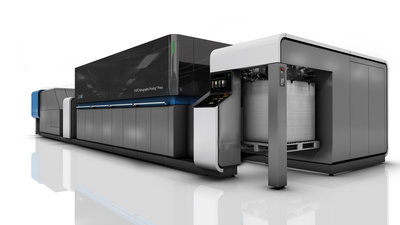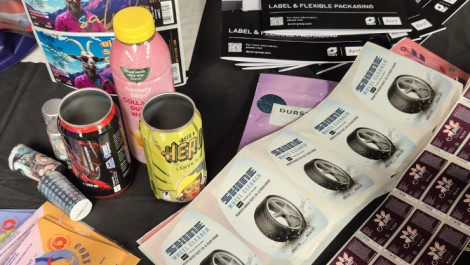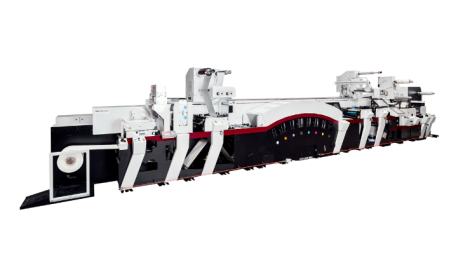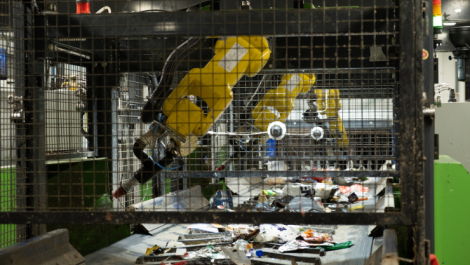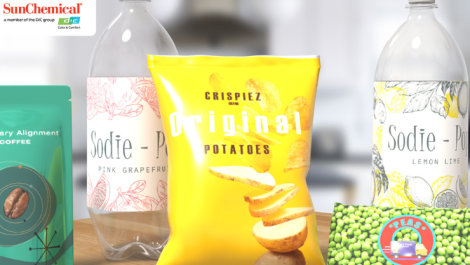Landa S10FC B1 carton press
Technical editor, Sean Smyth, caught up with Benny Landa when he was in London recently to find out the latest news on how his company is bringing its digital nanography presses to market, with a view to the potential packaging applications.
Last year’s big news was the return of Benny Landa with a brand new digital printing technology that would be an alternative to mainstream analogue print technology. The presses were sleek, futuristic and beautifully designed. He got Heidelberg, manroland and Komori to licence the process and give a ringing endorsement to (potentially) sceptical converters. It was a great show, even if the first print samples were not brilliant, with lots of print faults and artefacts.
The team at Landa has since been busy, visiting potential customers and ironing out problems while refining the technology and improving the design of the presses. Benny Landa was in London recently, and we took the opportunity of catching up with him to find out the latest news on the developments.
Mr Landa was on very good form, confident and optimistic about the industry in general and very bullish about his technology. The technical news was positive with the quality and consistency much improved. He had some very impressive samples on a range of substrates (including tissue paper for toilet rolls to show the benefit of indirect inkjet), with cartons very much to the fore. He also confirmed that the company has succeeded in a round of financing, raising some $200 million to continue the development and ramping up equipment and ink production capacity. He also said there would be some more news on additional analogue machinery suppliers who may licence the technology.
Improve print
The imaging heads, or ink ejectors, have been upgraded to a higher resolution 1,200 dpi from the original 600 dpi, with either stochastic or AM screening. Mr Landa refused to comment on its partner vendors, but Kyocera was widely named as the supplier and it has a 1,200 dpi version of the KJ4 head, the KJ4B-1200, predicted to be commercially available early in 2014.
Whatever the identity, the good news is the print quality is greatly improved. The colour range is high and the level of detail very good indeed, with legible 2 point type even in reverse out mode. The ink has been improved and there are better software and control systems to aid quality, which Mr Landa claimed is now positioned at over 85% of the required offset equivalent level.
Design
The design of the presses has been changed significantly. The enormous touch screen control panel has been moved from the side of the press to becoming an operator cockpit control system at the delivery. Part of the redesign has come from feedback from potential customers, and the operators there.
After the launch last year, the company received letters of intent to buy the first presses from 410 potential customers, and these companies have been instrumental in providing feedback on the necessary features and quality required. Of these, 40% were from packaging converters, carton printers, labels and flexibles.
Cartons first
The first press to be launched will be the B1 format S10FC, an eight colour sheetfed carton machine that has a speed of 6,500 sheets per hour in CMYK mode. This handles cartonboard up to 800 microns, additional colours can be added with orange, green and violet increasing the colour gamut. There is no facility for a spot colour. It will include an analogue coater, for water-based or UV varnish that will take flexo plates to provide pattern coating to leave the glue flaps clear. Komori will manufacture the first carton presses, with orders placed for the new designs.
The water-based inks will be supplied in concentrated form, with users just adding tap water and the ink delivery system handling the mixing and delivery to the heads. The original packaging was a clever 15 litre collapsible pack, however, it is likely that the ink will be supplied in 200 litre drums to avoid too many changes. The ink has passed FDA food packaging tests and there should be few concerns as the ingredients are not present on any of the exclusion lists.
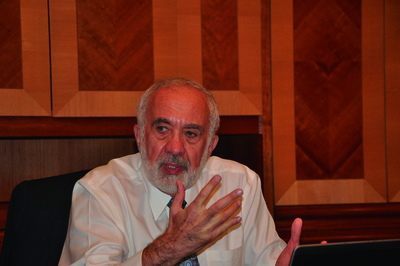 Benny Landa
Benny Landa
The detailed purchase and running costs of the process have not been made public. Users will buy the press and then pay a click charge that will cover the ink and consumables including replacement heads and belts that will be easily replaced by the press operator. The company claims that the low film weight will result in the lowest consumption of any digital colourant to achieve the same level of coverage.
Mr Landa said it will work out to be the lowest consumable cost of any digital print process. The economic cut off against sheetfed will be around the equivalent of 5-7,000 x B1 prints, which he said, ‘Will make the bulk of all printed jobs within the economic sweet spot of nanography.’
To be followed by…
After the carton machine, the next model will be the perfecting B1 machine for commercial print and then the simplex W10, which is aimed at flexible packaging with a likely launch date of early 2015. There was no indication of the narrow web press for labels, but that will follow.
Mr Landa had no news on machines from the licensees, apart from saying that the Landa badged machines would be the first to market.
While Benny Landa personally holds a record as the Israeli citizen with the highest number of patents assigned to him, he did not invent liquid toner offset printing in the Indigo process. It actually originated at the Research Laboratories of Australia thanks to Ken A Metcalfe’s invention back in 1952. What Indigo did was to commercialise it. Landalabs did not invent indirect inkjet – although the nano pigments are new – but Benny Landa is determined to make it work and push digital print firmly into the mainstream.
He is convinced that the quality and economics of the process will make nanography successful in mainstream print, labels and packaging. High quality is a base requirement, but it is the promise of being able to make money that will attract printers and converters.
The technology is being positioned to provide a lower cost for runs of the equivalent of up to 7,000 B1 sheets than from offset or flexo. As this covers the bulk of jobs (not necessarily overall volumes, which are skewed by the long runs), Mr Landa believes he is on to a winner. ‘It is the key driver,
lower cost for medium to high runs, that will really push digital to replace analogue.’ He believes that converters will use nanography to produce existing jobs more profitably than with their current print technology.
If he is correct (and look at his track record), Landa nanography will succeed and disrupt the existing supply chains.

